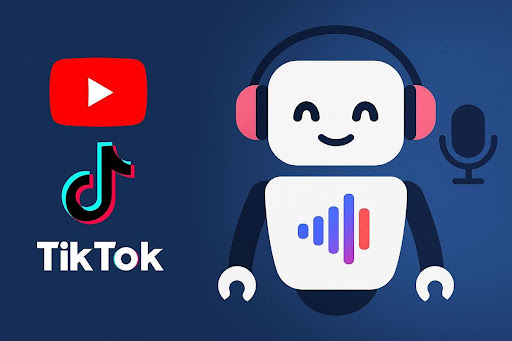
Voiceover AI for YouTube and TikTok: Meet Murf

If you're a YouTube or TikTok creator, you already know this: voiceovers work. They engage your viewers, drive the pace, and define the tone of your video. But sometimes recording your own voice just isn't the best choice. Perhaps your microphone situation isn't ideal. Perhaps you're shy in front of the camera. Or perhaps you're churning out a ton of videos and just want a quicker solution.
This is where Murf, a voice AI platform, comes in and disrupts. It's not merely voice-automation - it's opening doors to creators having a new, scalable means of sounding professional, staying brand-consistent, and posting reliably on platforms. Let's dive into how and why so many creators are using it.
Why Voiceovers Continue to Matter on Short and Long-Form Platforms
On TikTok, you’ve got seconds to grab attention. A strong voiceover can keep people watching, make your message clear, or add humour and emotion without needing to be on screen. TikTokers often use voiceovers to narrate stories, explain trends, or walk viewers through tutorials.
On YouTube, voiceovers propel substance. They underpin educational content, reaction clips, list videos, faceless channels, or anything scripted. In contrast to TikTok's rapid cuts, YouTube pays dividends for clear storytelling, and a steady, clean voiceover makes a huge difference.
But the thing is, not everybody feels like speaking into a mic. That's why there are voice AI solutions like Murf. You script the text, choose the voice, and produce the narration - all within your browser. No recording equipment required, no uncomfortable retakes, no quality of sound concerns. You have flexibility and quickness, and your material sounds professional each time.
How Murf Assists TikTok Creators Streamline and Scale
Murf's greatest strength on TikTok is velocity. You don't want to take 10 voice takes if you're responding to a trend, critiquing a product, or sharing a tale. Murf enables you to write your script, select a voice that best represents your tone, and have a ready-to-use voiceover in just minutes.
Suppose you're creating a "Things I Wish I Knew Before Moving to Spain" video. Rather than recording your voice in a bunch of loud takes, you can write out your points, select a voice that is friendly and conversational, and produce the narration in Murf. Then you just add that audio over your footage in your editing app and upload. That's it.
Want to experiment with several styles or languages? Murf provides you with various voice types - male, female, various accents, various languages - so your content becomes varied without re-recording.
There are even TikTok creators who batch their content. They'll script 10 videos, create all the voiceovers at once through Murf, and prepare a week's content ready to edit and upload. That's the level of consistency TikTok likes.
For YouTube Creators, Murf Solves Actual Workflow Headaches
YouTube videos are longer and more formal. That is, creators take longer to script, record, edit, and voiceovers tend to be where things drag on. Murf fills that gap.
Faceless YouTube channels particularly gain. These are channels where the host never shows up on camera - think tech tutorials, finance advice, travel vlogs, or history content. The visuals are from stock video, animations, or screen capture, and the voiceover holds it all together.
With Murf, creators can input their entire script, select a voice that best fits the tone of their channel (authoritative, friendly, energetic, etc.), and get the full narration in an instant. Need to modify a line? Simply edit the text and re-generate that section - no need for re-recording.
This is also ideal for creators who are not native English speakers or are not sure about their voice. Murf allows them to still create professional English content, or even publish in different languages, just by changing the voice settings.
Key Features That Make Murf Stand Out
Here's what creators actually use day-to-day when they work with Murf:
- Voice Library Murf has dozens of AI voices in various accents, tones, and languages. From a relaxed American tone to a corporate British narrator, the variety allows you to match the mood of your content.
- Text-Based Editing No scrubbing the timeline. You type, cut, and rearrange words as if editing a Google Doc. That speeds up the voiceover process considerably, particularly when you're fiddling with intros or transitions.
- Voice Customization Tools You can dial in pitch, speed, emphasis, and pauses to get the narration to sound more natural. That makes it less robotic and more suited to your video's tempo.
- Timeline Integration If you're creating the entire video in Murf, you can insert background music, sync voice with images, and export the entire video with voice and sound syncing. It's an all-out production environment.
- Multi-language Options If you're bilingual or targeting audiences in other regions, you can translate your script and create voiceovers in various languages. Same video, different markets.
The Bottom Line
You no longer need a professional mic. You don't need a soundproof room. You don't even need a loud, authoritative voice to produce the best content anymore. Platforms like Murf provide creators with the best thing: speed, reliability, and the ability to concentrate on ideas instead of voice takes. Whether you're an independent TikToker churning out daily content or a YouTuber building a long-term channel without revealing your face, voiceover AI is not just a hack. It is a clever, scalable creative asset. Murf enables that.